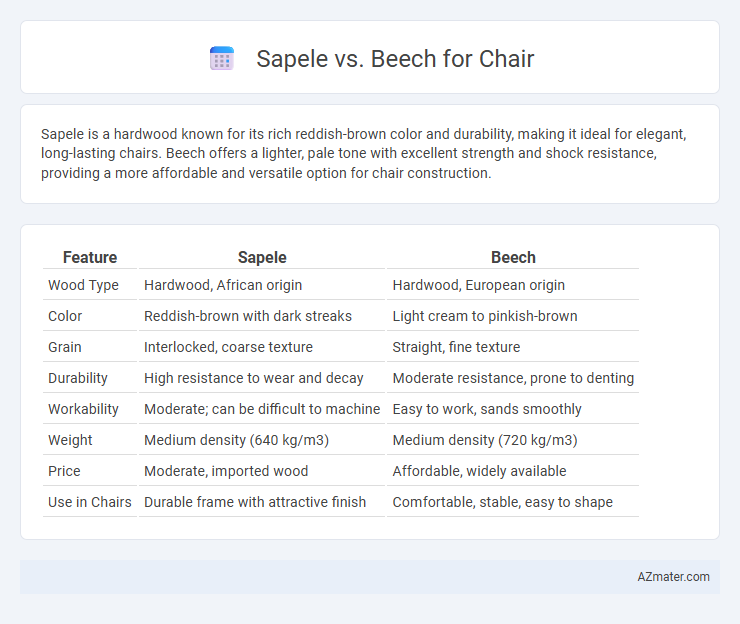Sapele is a hardwood known for its rich reddish-brown color and durability, making it ideal for elegant, long-lasting chairs. Beech offers a lighter, pale tone with excellent strength and shock resistance, providing a more affordable and versatile option for chair construction.
Table of Comparison
| Feature | Sapele | Beech |
|---|---|---|
| Wood Type | Hardwood, African origin | Hardwood, European origin |
| Color | Reddish-brown with dark streaks | Light cream to pinkish-brown |
| Grain | Interlocked, coarse texture | Straight, fine texture |
| Durability | High resistance to wear and decay | Moderate resistance, prone to denting |
| Workability | Moderate; can be difficult to machine | Easy to work, sands smoothly |
| Weight | Medium density (640 kg/m3) | Medium density (720 kg/m3) |
| Price | Moderate, imported wood | Affordable, widely available |
| Use in Chairs | Durable frame with attractive finish | Comfortable, stable, easy to shape |
Overview: Sapele vs Beech for Chairs
Sapele and Beech are popular hardwood choices for chairs, each offering distinct qualities suited for furniture making. Sapele, a dense African hardwood, provides excellent durability and a rich, reddish-brown hue that ages beautifully, enhancing chair aesthetics. Beech, a European hardwood, is known for its uniform grain, light color, and sturdy yet flexible properties, making it ideal for ergonomic and comfortable chair designs.
Botanical Origins and Appearance
Sapele, derived from the tropical African tree Entandrophragma cylindricum, features a reddish-brown hue with a distinctive interlocking grain that produces a subtle ribbon effect, offering durability ideal for chair construction. Beech, sourced from the temperate-climate European and North American Fagus species, exhibits a pale cream color with occasional pink or brown hues and a straight, fine grain that provides a smooth, uniform surface favored for ergonomic furniture. Both woods balance aesthetics and functionality, yet Sapele's tropical origin imparts greater hardness and moisture resistance compared to Beech's more flexible and shock-absorbent properties.
Hardness and Durability Comparison
Sapele wood, with a Janka hardness rating of around 1,410 lbf, offers greater resistance to dents and scratches compared to Beech, which has a Janka hardness of approximately 1,300 lbf. The natural oils in Sapele contribute to enhanced durability and resistance to moisture, making it a preferred choice for chairs subjected to frequent use. Beech, while slightly less hard, provides good shock resistance and stability but may require more maintenance to preserve its appearance over time.
Workability and Machinability
Sapele wood offers excellent workability with its fine texture and natural luster, making it ideal for detailed chair crafting, while beech provides superior machinability due to its hardness and uniform grain that allows smooth cutting and shaping. Both woods hold screws and nails securely, but sapele's interlocked grain can cause minor difficulties during planing compared to beech's consistent grain. Choosing between sapele and beech for chairs depends on the desired balance between aesthetic detail and ease of machining.
Grain Pattern and Aesthetic Appeal
Sapele exhibits a distinctive interlocked grain pattern with a rich reddish-brown hue that deepens over time, enhancing the natural elegance and warmth of chairs. In contrast, Beech features a straight, fine, and uniform grain with a pale cream color that offers a clean, smooth, and classic aesthetic ideal for contemporary or minimalist designs. The choice between Sapele and Beech for chair construction significantly impacts the visual texture and style, with Sapele providing a bold, exotic look and Beech delivering a subtle, refined appearance.
Weight and Strength Differences
Sapele wood typically weighs around 640 kg/m3, offering a strong but moderately dense material ideal for chair construction, while Beech wood weighs approximately 720 kg/m3, providing higher density and increased strength. The strength of Beech makes it more resistant to impact and stress, making chairs constructed from it more durable under heavy use. Sapele's lighter weight combined with good strength offers an excellent balance for ergonomic chair designs requiring portability without compromising stability.
Finishing and Staining Potential
Sapele offers a rich, reddish-brown hue with a natural luster that responds well to oil and varnish finishes, enhancing its fine, interlocking grain. Beech, with its pale cream color and smooth, uniform texture, absorbs stains evenly, allowing for consistent color application and a polished look. Both woods provide excellent finishing potential, but Sapele's pronounced grain can produce a more dramatic, textured appearance, whereas Beech results in a sleek, subtle finish ideal for modern chair designs.
Price and Availability
Sapele wood generally commands a higher price than Beech due to its rich, reddish-brown color and durability, making it a premium choice for chairs. Beech is more widely available in global markets, which often results in more competitive pricing and easier sourcing for furniture production. Availability of Sapele is more region-specific, primarily in West Africa, whereas Beech is commonly found across Europe and North America, influencing overall cost and supply consistency.
Suitability for Various Chair Styles
Sapele wood offers a rich reddish-brown hue and fine grain, making it ideal for traditional, Victorian, and classic chair designs that benefit from warm tones and elegant detailing. Beech, with its light color, uniform texture, and exceptional hardness, suits modern, Scandinavian, and minimalist chairs where a cleaner, straightforward aesthetic and durability are prioritized. Both woods provide strong structural integrity, but the choice depends on the desired chair style and visual impact.
Sustainability and Environmental Impact
Sapele wood is more sustainable than Beech due to its status as a fast-growing tropical hardwood often sourced from managed plantations, reducing deforestation risks. Beech, commonly found in temperate forests, faces increasing pressure from overharvesting and slower growth rates, raising concerns about long-term sustainability. Choosing Sapele for chair manufacturing can lower environmental impact by supporting responsible forestry practices and promoting carbon sequestration in tropical regions.

Infographic: Sapele vs Beech for Chair
 azmater.com
azmater.com